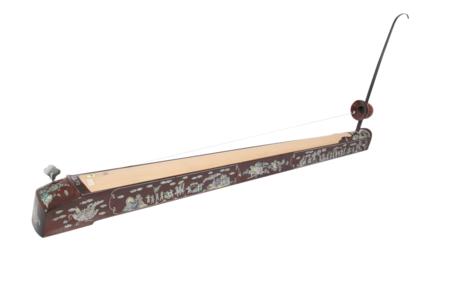This warning, probably coming from vigilant parents wishing to protect their daughters from the emotional appeal of love songs played on this instrument; this gives an idea of the power and charm of its music.
If one sound had to be chosen to evoke Vietnam, for many it would be the sound of the Monochord as it is one of only two traditional musical instruments of purely vietnamese origin. The word “Monochord” means gourd and refers to the dried gourd fastened to the handle, surrounding the string at the point where it connects to the handle. In the past this gourd may have served as a resonator, but today it survives as a decorative feature. Nowadays the Monochord is constructed using hardwood for a frame and softwood for the surface.
According to the “Dai Nam thuc luc tien bien” the first Monochord was made in 1770. At its first appearance it was a very simple instrument comprised of a bamboo section, a flexible rod, a calabash or half a coconut. After a process of evolution and improvement, the present form of the Monochord is a bit more sophisticated, yet still quite simple.

Monochord in general consists of 4 components including soundboard (resonator), spout, gourd, string and tuning peg.
The spout is a piece of bamboo or a buffalo horn that is square-framed at the root, while flat and gradually bent at the top. The spout plays an important role in producing sounds of different pitches beyond fundamental overtones of the instrument.
The string runs along the body of instrument. The past silk-made string is now replaced with iron one.
The gourd is made up from a half of a slender-necked gourd. The gourd covers the spout at the very point where the string is hung. The gourd contributes to increase the loudness of sound for the instrument. Nowadays, gourd is usually made from wood and therefore only served as an adornment.
The tuning peg is made from bamboo (if bamboo Monochord), or from wood (if wooden Monochord). The tuning peg is located at the inside frame towards the bottom of the soundboard. The string goes through a small hole at the end of the instrument’s surface and then gets through the tuning peg. In front of such a hole is a bridge to support the string.
The pluck is a pointed stick of bamboo or rattan.
The Monochord is usually tuned to the note C. It uses harmonies (or overtones). When playing the musician plucks the string while touching it lightly with the side of his hand at a point producing a harmony. But because the flexible rod causes the tension of the string to vary, the pitch may be made to rise or fall, the note may be lengthened or shortened, and trills may be played. The technique involving the fingers of the left hand includes vibrating, pressing, alternate pressing and releasing. The Monochord may be played on a scale consisting of third-tones or even quarter-tones.
The instrument is played solo or to accompany a poetry recital. During recent years, it has taken a role in orchestral accompaniment to cheo and cai luong opera.
The notes played by the Monochord are smooth, sweet, and captivating. In recent years success has been achieved in amplifying the sound, causing an increase in volume and distance the that the sound carries, while still preserving the quality of the sound.
With soft sounds, Monochord is suitably used in serene context. In the past, Monochord is the instrument of itinerant singers of Xam genre. Later, Monochord also participates in orchestra of Cheo genre, Tai tu style’s orchestra, in orchestra serving for declamation, in smaller ensemble or solo performance. There have been many musical pieces exclusively composed for Monochord, such as Vu Khuc Tay Nguyen (Dance of the Central Highland) by Duc Nhuan, Dong kenh trong (The clear channel) by Hoang Dam, Vi Mien Nam (for the South) by Huy Thuc, and so on.
Among many kinds of monochord of countries all over the world, there are Tuntina of India, Cung of East Africa, Tushuenkin of China. However, none of them can produce such a popular and highly artistic system of overtones as that of Monochord of Vietnam. The Monochord has been performed on major stages in foreign countries.
Tienghatquehuong
